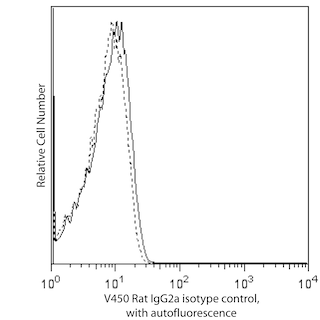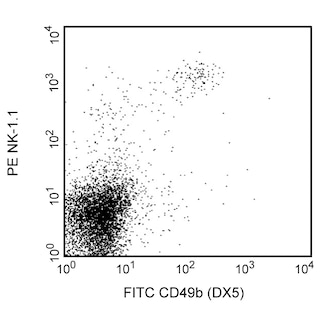Old Browser
This page has been recently translated and is available in French now.
Looks like you're visiting us from {countryName}.
Would you like to stay on the current country site or be switched to your country?




Multicolor flow cytometric analysis of CD146 expression on C57BL/6 splenocytes. Spleen cells were stained with FITC Rat anti-Mouse CD49b antibody (Cat. No. 553857/561067) and either BD Horizon™ V450 Rat IgG2a, κ Isotype Control (Cat. No. 560377; Left Panel) or BD Horizon™ V450 Rat anti-Mouse CD146 antibody (Cat. No. 562232; Right Panel). Two-color flow cytometric dot plots showing the correlated expression patterns of CD49b versus CD146 (or Ig isotype control staining) were derived from gated events with the forward and side light-scatter characteristics of viable splenocytes. Flow cytometry was performed using a BD™ LSR II Flow Cytometer System.


BD Horizon™ V450 Rat Anti-Mouse CD146

Regulatory Status Legend
Any use of products other than the permitted use without the express written authorization of Becton, Dickinson and Company is strictly prohibited.
Preparation And Storage
Product Notices
- Please refer to www.bdbiosciences.com/us/s/resources for technical protocols.
- Caution: Sodium azide yields highly toxic hydrazoic acid under acidic conditions. Dilute azide compounds in running water before discarding to avoid accumulation of potentially explosive deposits in plumbing.
- For fluorochrome spectra and suitable instrument settings, please refer to our Multicolor Flow Cytometry web page at www.bdbiosciences.com/colors.
- BD Horizon V450 has a maximum absorption of 406 nm and maximum emission of 450 nm. Before staining with this reagent, please confirm that your flow cytometer is capable of exciting the fluorochrome and discriminating the resulting fluorescence.
- Pacific Blue™ is a trademark of Molecular Probes, Inc., Eugene, OR.
- Since applications vary, each investigator should titrate the reagent to obtain optimal results.
- An isotype control should be used at the same concentration as the antibody of interest.
Companion Products




The ME-9F1 monoclonal antibody specifically binds to mouse CD146. The CD146 adhesion molecule is a type 1 transmembrane glycoprotein and member of the immunoglobulin superfamily. CD146 is expressed by blood vessel endothelial cells and may play roles in forming intercellular junctions between endothelial cells and influencing the transendothelial migration of other cell types. CD146 is also expressed by some melanoma cell lines, NK cells and neutrophils. CD146 is not detectable on mouse monocytes, dendritic cells, T cells, NKT cells, B cells and smooth muscle cells. Increased expression of CD146 is reportedly associated with NK cell maturation and may be used to characterize different functional NK cell subsets. Activated CD146-positive mouse NK cells reportedly are less cytotoxic and secrete less IFN-γ than their CD146-negative counterparts.
The antibody is conjugated to BD Horizon™ V450, which has been developed for use in multicolor flow cytometry experiments and is available exclusively from BD Biosciences. It is excited by the Violet laser Ex max of 406 nm and has an Em Max at 450 nm. Conjugates with BD Horizon™ V450 can be used in place of Pacific Blue™ conjugates.

Development References (4)
-
Alais S, Allioli N, Pujades C, et al. HEMCAM/CD146 downregulates cell surface expression of beta1 integrins. J Cell Sci. 2001; 114(Pt 10):1847-1859. (Biology). View Reference
-
Despoix N, Walzer T, Jouve N, et al. Mouse CD146/MCAM is a marker of natural killer cell maturation. Eur J Immunol. 2008; 38(10):2855-2864. (Biology). View Reference
-
Schrage A, Loddenkemper C, Erben U, et al. Murine CD146 is widely expressed on endothelial cells and is recognized by the monoclonal antibody ME-9F1. Histochem Cell Biol. 2008; 129(4):441-451. (Clone-specific: Flow cytometry, Immunofluorescence, Immunohistochemistry, Immunoprecipitation). View Reference
-
Yang H, Wang S, Liu Z, et al. Isolation and characterization of mouse MUC18 cDNA gene, and correlation of MUC18 expression in mouse melanoma cell lines with metastatic ability. Gene. 2001; 265(1-2):133-145. (Biology). View Reference
Please refer to Support Documents for Quality Certificates
Global - Refer to manufacturer's instructions for use and related User Manuals and Technical data sheets before using this products as described
Comparisons, where applicable, are made against older BD Technology, manual methods or are general performance claims. Comparisons are not made against non-BD technologies, unless otherwise noted.
For Research Use Only. Not for use in diagnostic or therapeutic procedures.
Report a Site Issue
This form is intended to help us improve our website experience. For other support, please visit our Contact Us page.